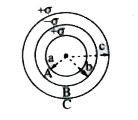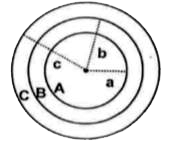Three concentric metallic spherical shells A,B and C of radii a,b and c(a<b<c) have surface charge densities +σ,−σand +σ respectively ,the potential of shell B is
σε0[b2−c2b+a]
σε0[b2−c2c+a]
σε0[a2−b2a+c]
σε0[a2−b2b+c]
The correct Answer is:D
To find the potential at shell B due to the three concentric metallic spherical shells A, B, and C, we can follow these steps:
Step 1: Understand the Configuration
We have three concentric metallic spherical shells:
- Shell A with radius a and surface charge density +σ
- Shell B with radius b and surface charge density −σ
- Shell C with radius c and surface charge density +σ
Given the relation a<b<c.
Step 2: Determine the Potential at Shell B
The potential at a point due to a charged spherical shell can be calculated using the following principles:
1. The potential inside a conducting shell is constant and equal to the potential on its surface.
2. The potential outside a charged shell behaves as if all the charge were concentrated at the center.
Step 3: Calculate the Contribution to Potential at Shell B
The potential VB at shell B will be the sum of the potentials due to shells A, B, and C.
1. Potential due to Shell A (outside point for A):
VA=kQAb
where QA=σ⋅4πa2.
2. Potential due to Shell B (on the surface):
VB=kQBb
where QB=−σ⋅4πb2.
3. Potential due to Shell C (inside point for C):
VC=kQCc
where QC=σ⋅4πc2.
Step 4: Substitute the Charge Values
Now substituting the charge values into the potential equations:
1. For shell A:
VA=k(σ⋅4πa2)b
2. For shell B:
VB=k(−σ⋅4πb2)b=−kσ⋅4πb
3. For shell C:
VC=k(σ⋅4πc2)c=kσ⋅4πc
Step 5: Combine the Potentials
Now, we can combine all the contributions:
VB=VA+VB+VC
Substituting the values:
VB=kσ⋅4πa2b−kσ⋅4πb+kσ⋅4πc
Step 6: Factor Out Common Terms
Factoring out kσ⋅4π:
VB=kσ⋅4π(a2b−b+c)
Step 7: Final Expression
Thus, the potential at shell B is given by:
VB=4πkσϵ0(a2b−b+c)
We have three concentric metallic spherical shells:
- Shell A with radius a and surface charge density +σ
- Shell B with radius b and surface charge density −σ
- Shell C with radius c and surface charge density +σ
The potential at a point due to a charged spherical shell can be calculated using the following principles:
1. The potential inside a conducting shell is constant and equal to the potential on its surface.
2. The potential outside a charged shell behaves as if all the charge were concentrated at the center.
The potential VB at shell B will be the sum of the potentials due to shells A, B, and C.
VA=kQAb
where QA=σ⋅4πa2.
VB=kQBb
where QB=−σ⋅4πb2.
VC=kQCc
where QC=σ⋅4πc2.
Now substituting the charge values into the potential equations:
1. For shell A:
VA=k(σ⋅4πa2)b
2. For shell B:
VB=k(−σ⋅4πb2)b=−kσ⋅4πb
VC=k(σ⋅4πc2)c=kσ⋅4πc
Now, we can combine all the contributions:
VB=VA+VB+VC
Substituting the values:
VB=kσ⋅4πa2b−kσ⋅4πb+kσ⋅4πc
Factoring out kσ⋅4π:
VB=kσ⋅4π(a2b−b+c)
Thus, the potential at shell B is given by:
VB=4πkσϵ0(a2b−b+c)
Topper's Solved these Questions
- ELECTROSTATICSBOOK - RESONANCE ENGLISHCHAPTER - ELECTROSTATICSEXERCISE - HLP
40 Videos
- ELECTROSTATICSBOOK - RESONANCE ENGLISHCHAPTER - ELECTROSTATICSEXERCISE - Exercise - 3 Part - I
33 Videos
- ELECTROMAGNETIC INDUCTIONBOOK - RESONANCE ENGLISHCHAPTER - ELECTROMAGNETIC INDUCTIONEXERCISE - A.l.P
19 Videos
- EXPERIMENTAL PHYSICSBOOK - RESONANCE ENGLISHCHAPTER - EXPERIMENTAL PHYSICSEXERCISE - PART -II
10 Videos
Similar Questions
Three concentric metallic spherical shell A,B and C or radii a,b and c(a<b<c) have surface charge densities −σ,+σand−σ. Respectively. The potential of shel A is :
View SolutionThree concentric spherical metallic shells A,B and C of radii a,b and c (a<b<c) have surface charge densities σ,−σandσ respectively.
If the potential of shell B is VB=σ∈0(anb−b+c) and the potential of shell C is VC=σ∈0(anc−bnc+c) then n is .
View Solution
Knowledge Check
Three concentric spherical shells have radii a,b and c(a<b<c) and have surface charge densities σ,−sigam and σ respectively. If VA,VB and VC denote the potentials of the three shells, then for c=a+b, we have
AVC=VB=VABVC=VA≠VBCVC=VB≠VADVC≠VB≠VA
Three concentric spherical metallic spheres A,B and C of radii a,b and c(a<b<c) have surface charge densities σ,−σ and σ respectively.
View SolutionThree concentric spherical metallic shells A,B,andC of radii a,b,andc(a<b<c) have surface charge densities σ,−σ and σ, respectively.
If VA,VB and VC are potential of shells A, B and C, respectively, match the columns
Column AColumn Ba.VAi.σε0[a2−b2+c2c]b.VBii.σ2ε0[a2b−b+c]c.VCiii.σε0[a−b+c]
View SolutionThree concentric spherical shells have radii a,b and c(a<b<c) and have surface charge densities σ,−σ and σ respectively. If VA,VB and VC denote the potentials of the three shells, then for c=q+b, we have
View SolutionThree concentric spherical metal shells A.B.C of radii a,b,c(c>b>a) have surface charge density +σ,−σand+σ respectively. The potential of the middle shell is σε0 times

View SolutionThree concentric charged metallic spherical shells A, B and C have radii a,b and c, charge densities σ,−σ and σ and potentials VA,VB and VC respectively. Then which of the following relations is correct?

View SolutionThere are three concentric thin spheres of radius a,b,c(a>b>c). The total surface charge densities on their surfaces are σ,−σ,σ respectively. The magnitude of the electric field at r (distance from centre) such that a>r>b is:
View SolutionThere are three concentric thin spheres of radius a,b,c(a>b>c). The total surface charge densities on their surfaces are σ,−σ,σ respectively. The magnitude of the electric field at r (distance from centre) such that a>r>b is:
A. 0
B. σε0r2(b2−c2)
C. σε0r(a2+b2)
D. none of these
View Solution
